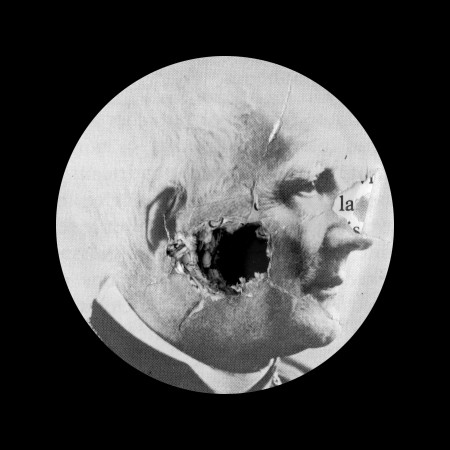Étienne Tremblay-Tardif’s installation Bookworms, at ARPRIM, is part print exhibition, part performance, and part audience participation. The deafening sounds of drilling accompany a video projected largely onto the gallery’s back wall. The color video is a close up shot of two feet standing on a stack of Quebec history books, and a drill descending into them.
Hung facing each other on either side of the room are 16 square enlargements of portraits of men from inside the pierced books. Each grainy black and white image has drill holes in it that look like bullet holes. Along the holes’ edges are rips and fragments of upturned paper bits like edges of pulpy decay, or bizarre textual skin affectations. There is a reverence here, but at the same time a violence to how these men, via their image, are resurrected. It is truly ‘iconophile and iconoclast,’ as proclaimed in the press release.
On the floor is a carpet of print, composed of books pages, grainy black and white images of violent police encounters from the late sixties and early seventies, and a chronology of events of political violence in Quebec for a decade leading up to 1972. Scattered over top it all are nearly 50, holey Quebec history books. These documents contextualize Quebec’s student uprising by directly referencing the violent aspects of the Quiet Revolution’s legacy. This historical perspective on recent protests raises pointed questions about our history of cultural revolutions, and their violent characterization.
With Bookworms, Tremblay-Tardif unearths history and creates questions without ever imposing closure. The history being brought to light so violently never seems to get judged, and no alternative story or discourse is presented to replace it.
To me, Tremblay- Tardif’s act of drilling through history books not only questions the authority represented by the figures on the wall, but completely invalidates it. His drill-hole assassinations obliterate the bearers of a stiflingly exclusive vision of Quebec history. In many ways, a blank space is created for whatever we chose to replace it with. As such, this installation is freeing. Just as Tremblay- Tardif decimates the books, we are allowed to handle and walk all over these documents of history, and think for ourselves about who we are, and where we stand.
ARPRIM, space #426
Étienne Tremblay- Tardif
Bookworms
2 November- 8 December, 2012
www.arprim.org



